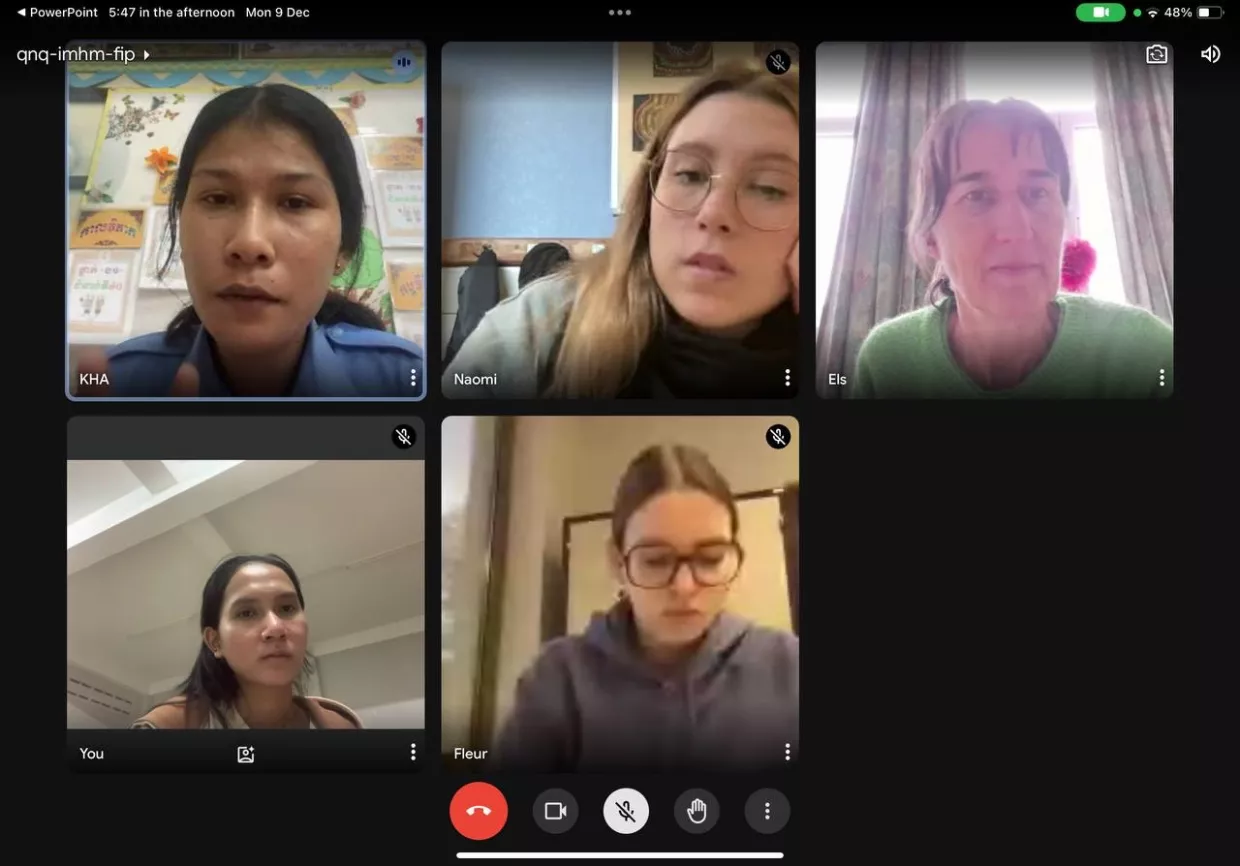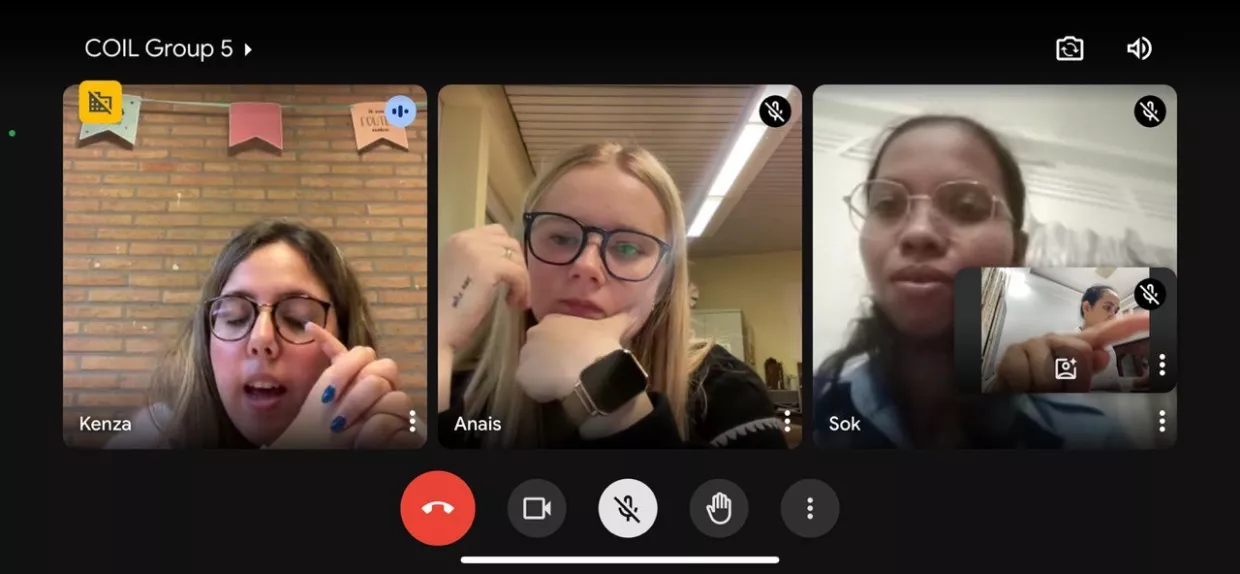Join our newsletter
By subscribing you agree to our Privacy Policy

From Ghent to Kampong Cham
One campus is surrounded by Cambodian nature; the other is a stone’s throw from the busy ring road in Ghent. Although teacher training programmes in Belgium and Cambodia might seem worlds apart at first glance, students discovered during an online exchange that they had more in common than they initially thought. “It’s essential to keep an open mind,” says student Lien.
In autumn 2024, students from primary teacher training courses in Belgium and Cambodia met as part of a COIL project. COIL (Collaborative Online International Learning) gives students the opportunity to develop intercultural skills without having to take a flight abroad, making this kind of Internationalisation at Home also an environmentally friendly alternative. “Internationalisation changes your perspective and gives you a better idea of the kind of teacher you want to become,” says Cambodian teacher trainer Phannha.

How do you set up a COIL project when you’re thousands of kilometres apart? Online meetings might make international exchange more practical, they certainly don’t remove the need for preparation, clear communication and mutual trust.
“A while ago we responded to a call to collaborate with a Cambodian teacher training college,” says Els De Latter, lecturer in practice and workshop for the Bachelor of Primary Education at Artevelde University of Applied Sciences. “Once our proposal was accepted, we visited our partner school in Cambodia, and colleagues from the Provincial Teacher Training College and Regional Teacher Training College in Kampong Cham visited Belgium in return. These visits were crucial to get to know one another and to prepare the collaboration. Are there relevant topics for both groups? What assignments do we give to our students? Many aspects of the programme were still unclear.”
Teacher trainers Chinda and Phannha from the Provincial and Regional Teacher Training College in Kampong Cham also emphasise the importance of thorough preparation. “It’s important to agree on clear guidelines in advance, choose a suitable theme and use the right platform. By exchanging videos and information via Facebook before the first meeting, for example, you get to know each other more quickly and can collaborate more effectively.”
Even though there were plenty of topics for discussion, the teacher trainers were unsure whether the exchange would really take off. “We weren’t sure if a COIL project would be well received,” admits Phannha. “This was our first time setting up such a project with a European country. Our students were a bit uncertain about their English skills, but also very eager to learn more about another educational context.”
The students themselves were also unsure what to expect: “I was afraid the conversation would be one-sided, but it was great to see that our Cambodian fellow students were really motivated too,” says Naomi. In groups of six, three Belgian and three Cambodian students, they introduced themselves and their campuses. They also gave each other insight into what life as a primary school teacher looks like in both countries.
The initial concerns from the teacher trainers proved unfounded, as the exchange turned out to be a success – with the expected obstacles, of course. Internet connections weren’t always stable, the time difference was challenging, and language barriers occasionally led to misunderstandings. On the latter point, Eliane highlights the students' solidarity: “Everyone helped each other when we struggled to find the right words in English. That teamwork was beautiful to see.” Chinda adds that although the language barrier initially made Cambodian students hesitant, it didn’t hinder the exchange: “We realised that we were all outside our comfort zones. Ultimately, learning is more important than language proficiency.”

During an intercultural exchange, it’s only natural to focus on the differences between your own situation and that of the partner school, especially when the aim is to learn about other educational contexts. But what the students didn’t expect was that the project would also be a mirror, showing what they would like to see changed in their own systems.
“I was pleasantly surprised by the community work in Cambodian schools,” says student Fleur. “Taking care of your school environment together strengthens the bond. I think we could learn a lot from that.” Student Lien was also impressed by the Cambodian teacher training: “The programme lasts two years, but it’s quite intensive. I might have had a stereotypical image of it, like it wouldn’t cover much.” For the Cambodian students, the exchange shifted their view of the teaching profession: “Our students got the impression that the expectations around teaching are very different. Whereas teaching in Belgium is seen as a demanding job with little reward, in Cambodia it’s considered a privilege to stand in front of the class. Some students even said they felt more motivated to contribute to education in Cambodia as a result.”
That comment from the Cambodian students revealed an unexpected point of connection. “You could always go into teaching”: a well-meaning piece of advice heard when things don’t work out elsewhere in the job market. The fact that a teaching career has long been viewed as a ‘last resort’, rather than a respectable profession, has done no favours to the teacher shortage in Belgium. An article in the education magazine Klasse from May 2025 attributes the shortage to the sector’s negative image: high workload, little flexibility, and a high risk of burnout.
In Cambodia too, the number of qualified teachers is not in balance, with major differences between provinces and a notable concentration in rural areas. In 2023, Cambodia’s Ministry of Education, Youth and Sport published a strategic plan for 2024–2028. It included action points to tackle the teacher shortage and improve the quality of education. Alongside long-term reforms, the government is also looking for quick wins, such as increasing the number of contract teachers, encouraging double shifts, and setting up multi-grade classes.
These measures are also reflected at the Provincial and Regional Teacher Training College in Kampong Cham. Students who consider a teaching career must first pass a rigorous national entrance exam. Only the top candidates are allowed to start the training programme, which is made more attractive with a government allowance.
“Our teacher training programme hasn’t always been stable,” says Chinda. “During the COVID-19 pandemic, the government didn’t organise any entrance exams. And no exam means no students. It will take a while before our programme is stable again.”
What the students take away goes beyond inspiration for their own teaching practice; many have developed a real appetite for further intercultural exchange. “There could definitely have been more meetings,” says Eliane. “That would have helped build even more trust on both sides and given the exchange more depth.” Lien also looks back warmly, despite the short timeframe: “You always take something with you, no matter how short it is. You don’t have to take giant leaps right away. Baby steps matter more.”
Chinda and Phannha are convinced of the COIL project’s added value, particularly regarding the intercultural competencies their students develop: “As a teacher, it’s important to learn from education practices around the world. By integrating them into your lessons, you not only become a better teacher, but someone with a broader outlook. After all, we don’t live in one country. We live together on the same planet.”
By subscribing you agree to our Privacy Policy
Julien Dillensplein 1 bus 2A
1060 Brussels
Belgium